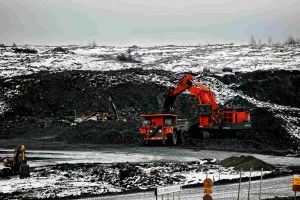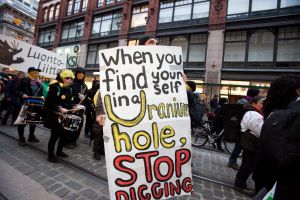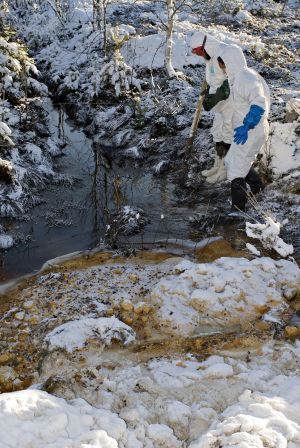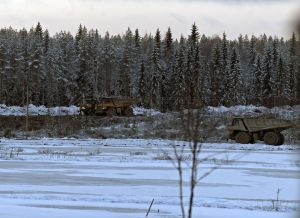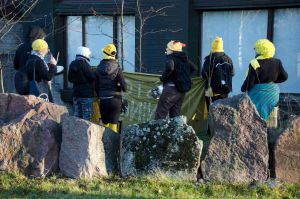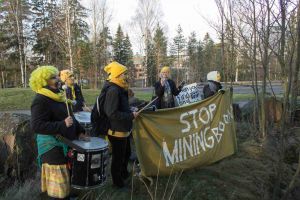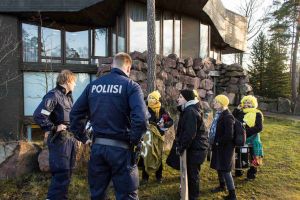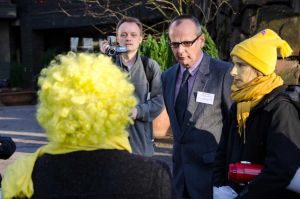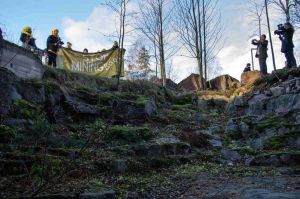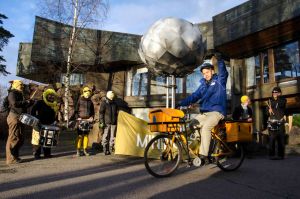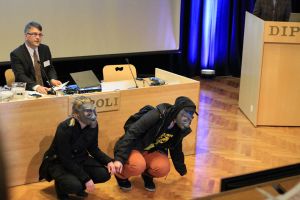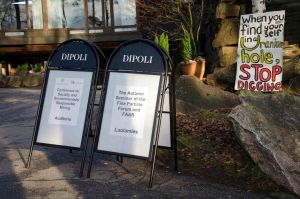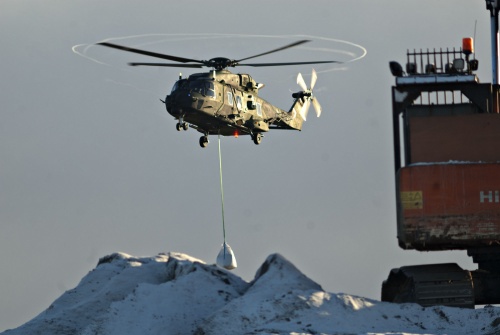Talvivaara mine: environmental disaster in Finland
Talvivaara: Environmental Disaster in Finland
Since November 4, 2012[1] a cocktail of poisonous chemicals leaked from the Talvivaara mine in Eastern Finland to the surrounding rivers and lakes. An investigation of the Finnish Environment Institute found high levels of aluminium, cadmium, nickel, uranium and zinc in the released waste waters. In a big demonstration led by people from Eastern Finland on November 14, 2012 about 1,000 people demanded the mine's closure. A petition with some 18,000 signatures[2] was handed over to the Minister of Environment.[3] The number of signatures is still increasing - as of November 18 about 20,000 people had signed the petition[4]. At the same time a small rally took place in Oulu.
Only during the first day of the disaster, over 220,000 cubic metres of waste water have leaked from a gypsum waste pond at the Talvivaara mine in Kainuu. Some of the water has spilled to an area outside the mine.[5] The leakage continued for at least ten days. The operator of the mine tried for weeks to close the leak[6]. On November 8 they announced to have blocked a leak at its gypsum pond. Only half a day later a new leakage was reported.[6] The same happened again with the "all-clear" message of November 14th, when it was announced again the leakage was eventually blocked - one week later the safety dam was reported to be leaking again[7]. It is estimated that over 10,000 kilos of nickel and unknown amounts of uranium escaped the mine[6].
According to the Kainuu Employment and Economic Development Centre the gypsum pond was not supposed to be used for storing waste waters, and that there had not been any special permit for that. On November 8, Minister of Environment Ville Niinistö called the leak a "serious environmental crime".[6] For years local people had accused Talvivaara to have extracted hundreds of tons of uranium a year without permission.[8]
For several days the Talvivaara company was not able to locate the site of the leak[9]. Since the beginning of the catastrophe, the mine has discharged hundreds of thousands of cubic metres of toxic effluent into the nearby environment[10]. According to a local newspaper some 4,000 cubic metres of waste water escaped the Talvivaara mine per hour[11]. Greenpeace called it "Finland's biggest chemical catastrophe in history"[1].
The mine has leaked heavy metals like cadmium and nickel into its surroundings and nearby lakes. The uranium concentration in the effluent has risen by 100-200 times its normal level in the bottom and surface waters.[10] Military and civil helicopters were in operation to plug the leaks in the waste water dam. "Helicopters are used to dump neutralizing calcium into the waste water, as well as moving concrete and patching material to leakages" explained the news company YLE. Some 150-200 people were busy to block the leaks and to build a safety dam, said Talvivaara Head of Communications Olli-Pekka Nissinen.[12] Also soldiers from the Kainuu Brigade and local volunteer fire fighters were involved to the rescue activities[13].
According to the Finnish authorities, "pollutants in nearby waterways are at levels that may cause the death of fish and affect plants and bottom-dwelling organisms". Although the the Finnish Radiation and Nuclear Safety Authority claimed the released uranium would not pose a threat to neither environment nor humans, they at the same time admitted it to be a potential health risk when it makes its way into drinking water.[14]
Chair of the parliament’s Environment Committee Matti Korhonen said on November 14 authorities should prevent the mine from resuming operations[15].
On November 13, 2012, it was reported that STUK had detected uranium levels in water samples at 350 microgrammes per litre, while the recommended limit is 100 microgrammes.[16]
The company's operation at the Talvivaara mine were shut down after the disaster. Though the company appealed to the authorities to receive a permission for re-starting the business, officials stated this would not happen soon. First investigations have to be taken to understand the causes of the catastrophe and to investigate on the violations of law committed by the company.[17] Such an inspection by the Finnish Safety and Chemicals Agency (Tukes) and Kainuu centre for Economic Development,Transport and the Environment (KAIELY) took place on November 19, 2012[18] - a delegation of independent observers was prevented from joining the inspection[19].
November 22, People's Movement for the Lakes and Rivers informed about a new leakage found in the safety dam. According to them, Talvivaara Mining Company Plc started emergency liming with help of two helicopters dropping the lime from 300-500 kg containers. People's Movement for the Lakes and Rivers reported again the Lumijoki river carrying a foul stench and a strong odour of sulphur; the color of the flowing water down below from the dam was described to be alarming as in the beginning of the gypsum pond leak: brownish dark yellow. KAIELY played down the incident speaking about "seeking" which wouldn't be seen as a threat. Eventually the government admitted the new leak. People's Movement for the Lakes and Rivers criticized the government's perspective of a "stabilized situation", as it was obviously since the beginning that the "safety dam" and the "back-up pond" wouldn't provide a "stabilized situation".[20]
At least 100 hectares (approx 250 acres) of marshland, streams, lakes and ponds have been polluted by the discharges of waste waters containing uranium and heavy metals. Through heavy application of lime up to a thousand kilogrammes of liquid uranium has accumulated as sediment in the grounds and vegetation of the area. The uranium and the heavy metals such as nickel are about to enter the Vuoksi water system, where they could contaminate 1,000 million cubic metres of water over the level of environmental danger.[21]
Chemical-Environmental Aspects of Talvivaara Spill
Volume and localisation of the spill
The Talvivaara nickel mine gypsum pond spill of November 2012 has been reported to have involved 1 million cubic meters of contaminated liquid (1,000,000,000 litres). Based on the pond dimensions figures between 1.4 and 3 million m³ have also been estimated. A substantial part of the spill gathered in emergency ponds which mainly consist of swamp areas. There are major concerns because the safety ponds have leaked, which was discovered and documented by environmentalists; and as the ponds lack any bottom lining, thus are not isolated from regional ground waters. At least 20,000 cubic meters of the spill entered in the northern Oulujoki-waterway. The major leak to the south through the lake Ylä-Lumijärvi in the major East Finland Vuoksi- waterway included at least 200,000 cubic meters of waste water.[22]
Large amounts of lime (calcium oxide, CaO) have been dumped by helicopters to a swamp and river in the southern leak area in an attempt to precipitate some of the metals.
Total amounts of uranium, heavy metals, aluminium and sulfates in nature
Substantial amounts of uranium and metals have been measured from a contaminated land area of approximately 5 hectares located below the last emergency pond. The highest uranium concentration measured by the state radiation authority has been 260 mg/kg[23], and about 200 mg/kg[24] dry weight by environmental organisation with the only heavy metal analysis of the material. The legal limit of radiation waste is 1,000 Bq or 40 mg uranium/kg[25], but the authority is reluctant to classify the waste material as radioactive. Classification would possibly lead to legal issues with the mine environment and process permits. Only an environment permit for uranium “recovery” factory has been applied (under review), it is not for an enrichment process including radiation risks. The land precipitated colourful slurry (“mönjä”) material would appear to be a minor part of the spill as the pH of the leak was about 4-5. After publication of the presence of “mönja” by local environmental organisations and some protests, Talvivaara has started an operation to clean the region.[26]
The concentrations of the major contaminants listed here are based on a citizen sample by local resident Ari Korhonen[27], and later official measurement by the inspection authority[28], which are similar. Cadmium levels are based on official figures. The volume is assumed as 220,000 m³. The further spill risks in the emergency ponds include even 10 fold larger amount of chemicals. Even though part of the material may be rescued from the land to be cleaned, the volume estimates by Talvivaara are likely to be too low. The amounts of contaminants are in tons except cadmium, for which the 4.2 kg is a substantial amount. There was 50, 2, and 2.9 grams per litre of sulfate, aluminium and manganese, respectively, and the sulfate quantity was 11 thousand tons.
Breach of environmental permit?
Considering the environmental safety Talvivaara has very high maximum concentration limits in its environmental permit (currently under review by Finnish authority, and by EU commission) for nickel and zinc, 1 and 2 mg/litre. It has no permit for uranium and cadmium (under review). The permit includes estimates of aluminium, sulfate, and manganese, which have been considered as binding norms for Talvivaara, when previous sulfate emissions were considered. Table includes column for how many fold the spill exceeded the concentrations in the permit. Breach of permit should lead to legal consequences to persons responsible, and the company is liable for damages.
Environmental toxicity standards
Nickel and zinc are toxic for the water nature at concentrations of some micrograms per litre. The EU quality norm for nickel is 21 micrograms per litre for inland surface water. The environmental effects of uranium are still not fully known, a review of EU SCHER science commission mention a preliminary environmental limit of 0.1 micrograms per litre[29]. Cadmium is an especially toxic heavy metal, which accumulates in the human body and in food chains. The EU quality norm of cadmium for inland surface waters is 0.1 micrograms per litre. Aluminium is acutely toxic to fish by blocking its gills. The highest toxicity is low acidic pH in the spill. Manganese is also toxic in waters and has reported to have neurotoxic effects in human at high amounts. The environmental safety limits used for aluminium and manganese are 27 micrograms and 1.2 mg per litre, respectively. The environmental standards, except of EU cadmium and the uranium value, were from table 3.4.1 of Australian government document[30]. Sulfate accumulates in deep regions of lakes, and causes lack of oxygen and can be degrade to highly toxic hydrogen sulphide. A limit of 50 mg/litre is recommended to avoid disturbances in fish eggs. The spill contained e.g. toxic heavy metals cobalt about 0.5 mg/litre and chromium almost 1 mg/litre[27] and fluoride 68 mg/litre[28]. Comparative environmental standards from Finnish ministry of environment[31].
Risks in the 2 waterways
Based on the environmental standards, the amount of water which can be contaminated over legal limits was calculated. One million cubic meters corresponds to a small lake with an area of 1 square km and depth of one meter (or e.g. 0.2 km² and 5 meter depth). A substantially big lake in the southern Vuoksi waterway is e.g. Syväri with about 500 million cubic meters volume. Using the quite strict environmental standards, the spill has a potential in both waterways to at least temporarily spoil many lake systems. Currently the major part of the spill is concentrated to deep parts of the first 2-3 lakes of both waterways. Measures to localise the waste to the lakes should be seriously considered. The concentrations and amounts of some key substances of the spill into the nature outside of the mine district, may have contaminated millions of cubic meters of inland surface waters.
Compiled by Jari Natunen, PhD, Biochemist.
Media releases
- Hätäjuoksutukset olisivat harkittu ympäristörikos (February 11, 2013)
- Talvivaaran ja Kainuun Ely:n pimittämät YSL62 ilmoitusten (2kpl) asiakirjat julkistettu (February 8, 2013)
- Hätätilanne Talvivaaran vuotojen osalta jatkuu (February 8, 2013)
- Häiritsivätkö aktivistit Talvivaaran velvoitetarkkailua? (February 1, 2013)
- Talvivaara haastoi lintukuvaajan käräjille (January 28, 2013)
- Operaatio Saukko - röyhkeä suunnitelma (January 23, 2013)
- Piilotteleeko Talvivaara biokasaliuotuksen ongelmia? (January 16, 2013)
- Uudet mittaustulokset varmistavat: Talvivaaran lähijärvet ongelmajätekaatopaikkoja (January 9, 2013)
- Talvivaaran lintukuolemien tutkinta ihmetyttää - Miksi poliisi ei tutki Talvivaaraa rikoksesta epäiltynä? (January 4, 2013)
- Kysymyksiä Talvivaarasta - Luonnonsuojelupiiriltä vireillepano Kainuun ELY-keskukselle (December 14, 2012)
- Kansalaisten kaivosseminaari - Talvivaaraa ei valvo kukaan (December 9, 2012)
- Kuka tutkii uraaniketjun myrkkyvaikutuksia? Vähättelyn kierre: vaikutuksia ravintoketjuhin ei ole huomioitu ennen lupia (December 5, 2012)
- Talvivaaran sakka kokonaan säteilyjätettä? Saastuneen suoalueen uraanipitoisuudet todistettavasti koholla (December 5, 2012)
- Kansalaisten kaivosseminaari - MITÄ TAPAHTUU TALVIVAARASSA? (December 4, 2012)
- Perä reveals the origin of water problems at Talvivaara Mine (November 29, 2012)
- Perä paljasti Talvivaaran vesiongelmien alkusyyn (November 29, 2012)
- Thousand kilogrammes of uranium in soluble form on the terrain - A massive risk to health and the environment (November 29, 2012)
- Kuka enää uskoo Talvivaaraselityksiä? Jyrkkä EI lähialueen ihmisiltä (November 28, 2012)
- Talvivaaran selitykset ontuvat (November 27, 2012)
- Tuhat kiloa liukoista uraania maastoon - Suuri ympäristö- ja terveysriski toteutui (November 27, 2012)
- Kansalaisten luontoretki tuhotulle Ylä-Lumijärvelle keskiviikkona 28.11.2012 (November 26, 2012)
- Kalakuolemia Talvivaaran pohjoispuolella. Vesien pH:ta on pohjoisen lähivesissä nostettu myrkylliselle tasolle (November 23, 2012)
- SAFETY DAM IS LEAKING - EMERGENCY LIMING HAS BEEN STARTED (November 23, 2012)
- PATO VUOTAA - HÄTÄKALKITUKSET OVAT ALKANEET (November 22, 2012)
- Talvivaara and Finnish Safety and Chemicals Agency (Tukes) do not wish the public to participate in the inspection at the mine (November 21, 2012)
- Is it possible to restart the Talvivaara metal plant? (November 18, 2012)
Background information
At the eastern Finnish Talvivaara Europes largest nickel open cast mine is situated. Since 2008 the mining is in operation 24 hours a day and moved more than 30 millions of tons of soil. In an area as big as 60 square kilometers mining, crushing, chemical treatment and extraction takes place. Besides nickel also big amounts of uranium, copper and cobalt are produced.
In February 2011 he Canadian uranium mining company Cameco made a contract with the Talvivaara operator to construct an uranium extraction facility with a capacity of 350 tons uranium per year. The last years, particularly in summer 2012 a movement against the uranium mine was established in Finland. However, the catastrophe in Talvivaara gathered an unexpected number of people to demonstrate to stop the operation and extension of the mine.
Material:
- photos of the rally in Helsinki (free to use, source must be mentioned)
- petition (scroll down for petition in english)
Further information:
- ↑ 1.0 1.1 http://www.greenpeace.org/international/en/news/Blogs/makingwaves/chemical-spill-finland/blog/42935/ as at November 17, 2012
- ↑ figure corrected from 17,000 to 18,000 after a direct information from Helsinki on November 17, 2012
- ↑ http://yle.fi/uutiset/stop_talvivaara_protest_brings_carnival_mood_to_helsinki/6376956 as at November 17, 2012
- ↑ source: personal information by email from Helsinki on November 18, 2012
- ↑ http://yle.fi/uutiset/talvivaara_waste_water_leaks_into_environment/6363459 as at November 17, 2012
- ↑ 6.0 6.1 6.2 6.3 http://yle.fi/uutiset/talvivaara_waste_water_leak_plugged/6369461 as at November 17, 2012
- ↑ Stop Talvivaara media release as at November 23, 2012
- ↑ http://www.stoptalvivaara.org/fi/newsstream.html as at November 17, 2012
- ↑ http://yle.fi/uutiset/talvivaara_struggles_to_find_leak/6366349 as at November 17, 2012
- ↑ 10.0 10.1 http://www.sll.fi/ajankohtaista/tiedotteet/2012/concern-over-toxic-leak-from-europe2019s-largest-nickel-mine-in-north-eastern-finland as at November 17, 2012
- ↑ http://www.stoptalvivaara.org/fi/waste-towards-savolax.html as at November 17, 2012
- ↑ http://yle.fi/uutiset/talvivaara_waste_water_pond_still_leaking/6371489 as at November 17, 2012
- ↑ http://yle.fi/uutiset/talvivaara_leak_continues/6371975 as at November 17, 2012
- ↑ http://yle.fi/uutiset/mine_leak_environmental_impact_worsens/6373577 as at November 17, 2012
- ↑ http://yle.fi/uutiset/environment_committee_chair_calls_for_halt_to_talvivaara_operations/6375739 as at November 17, 2012
- ↑ http://yle.fi/uutiset/more_heavy_metals_found_in_waters_around_talvivaara/6375294 as at November 12, 2012
- ↑ http://yle.fi/uutiset/probes_into_talvivaara_begin/6379370 as at November 12, 2012
- ↑ see Stop Talvivaara media release as at November 18, 2012
- ↑ see Stop Talvivaara media release as at November 21, 2012
- ↑ see Stop Talvivaara media release as at November 23, 2012
- ↑ http://www.stoptalvivaara.org/fi/release27112012.html as at November 28, 2012
- ↑ http://www.ely-keskus.fi/fi/tiedotepalvelu/2012/Sivut/Talvivaaranl%C3%A4hivesist%C3%B6jenk%C3%A4ytt%C3%B6suosituksiatarkennettu.aspx
- ↑ http://www.stuk.fi/sateilytietoa/sateily_ymparistossa/uraani/fi_FI/talvivaaran-kaivosalueen-vesistojen-uraani/
- ↑ http://suomenluonto.blogit.fi/talvivaaran-monjan-syvin-olemus/
http://www.suomenluonto.fi/talvivaara/Nayte_154920.pdf - ↑ http://www.stuk.fi/sateilytietoa/sateily_ymparistossa/uraani/fi_FI/uraanin-tyttaret/
- ↑ http://yle.fi/uutiset/yla-lumijarven_suoalueen_kunnostustyot_etenevat/6436307
- ↑ 27.0 27.1 http://talvivaaraymparisto.nettisivu.org/miksi-nama-sivut-tehtiin/dokumentit/purkuputki-nayte-06112012/
- ↑ 28.0 28.1 http://www.stoptalvivaara.org/fi/mittauslahteet.html
- ↑ http://ec.europa.eu/health/scientific_committees/environmental_risks/docs/scher_o_123.pdf
- ↑ http://www.mincos.gov.au/__data/assets/pdf_file/0019/316126/wqg-ch3.pdf
- ↑ http://yle.fi/uutiset/talvivaarasta_valui_halyttavan_paljon_alumiinia/6377060
- Action at mining seminar in Helsinki
